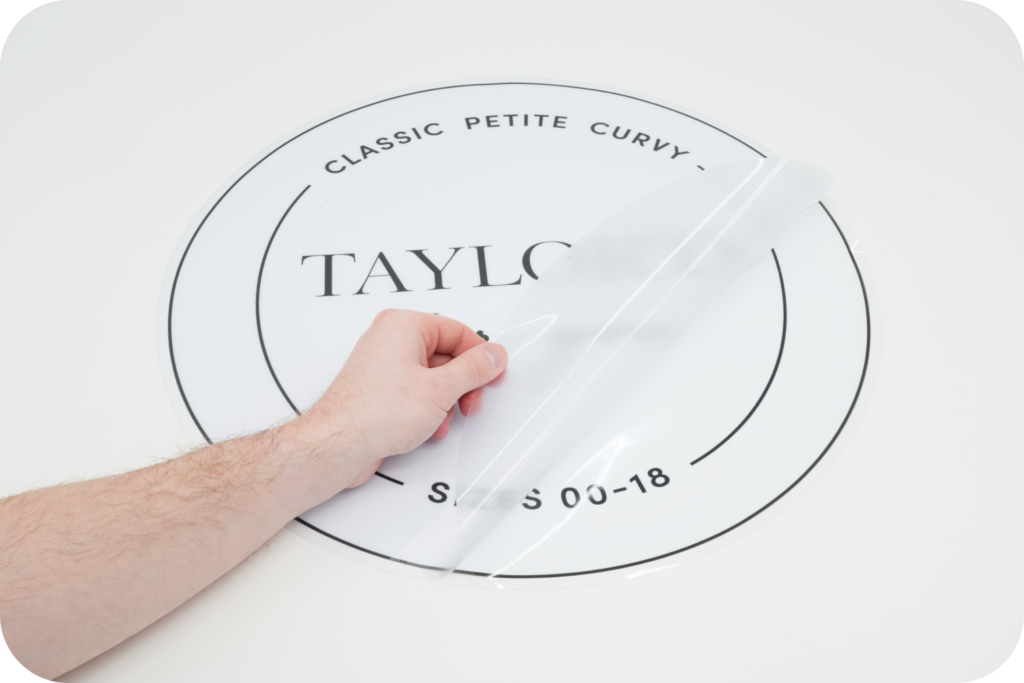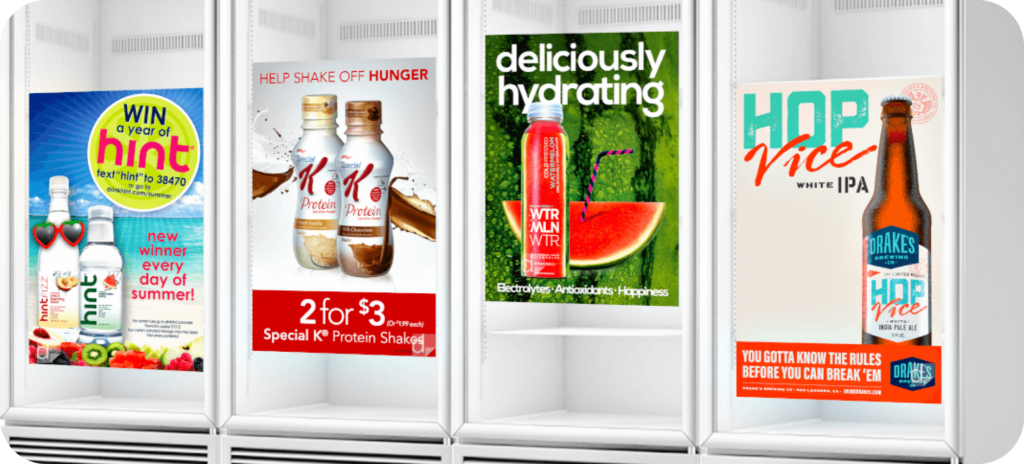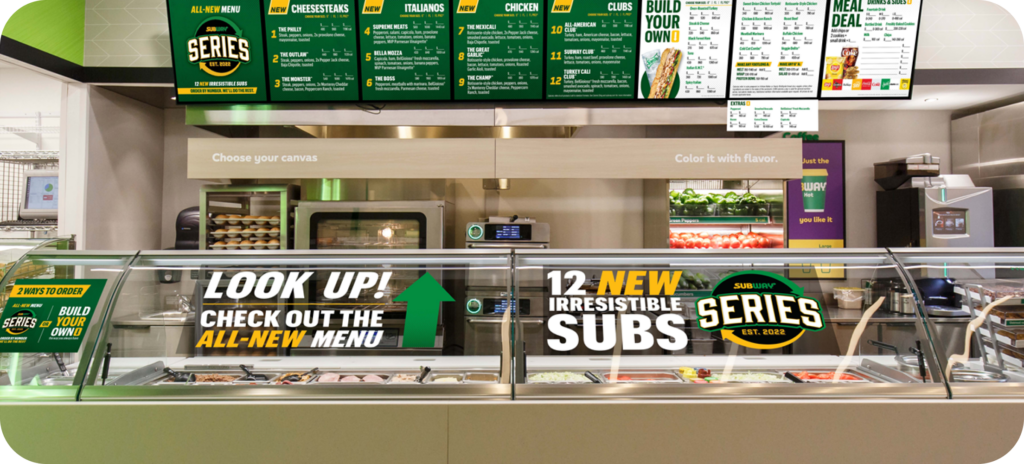
When it comes to decorating windows and other surfaces with a cling there are two main options to choose from, adhesive clings and static clings.
A “cling” refers to (typically a temporary, vinyl) decal material that adheres to a surface using alternative methods of attraction.
Both types of clings have their benefits and drawbacks, so the choice ultimately comes down to your environment and specific needs. In this blog post, we’ll take a closer look at adhesive clings and static clings to help you determine which type is better for your needs.
Static Clings
Static clings are a highly plasticized (typically vinyl) soft pliable film that attracts to a surface using cohesive force. Unlike the name suggests, static clings don’t actually use static electricity. They are ideal for temporary solutions and are easy to remove, leaving no residue or damage to the surface. Static clings are also very affordable, making them a popular choice for temporary promotions, sales, or events.

Advantages of Static Clings:
- Installation Ease: Unlike other types of window graphics, static clings do not require any special tools or skills to apply. They are attached to a clean, dry glass surface by simply peeling them off the backing paper and pressing into place, or using a wet spray or application fluid to provide a clear, no-bubble installation. These are generally twice as thick as low-tack adhesive clings, which provide a durable and clean look.
- Reusability: Static clings can be removed, stored, and re-used multiple times (if cleaned and maintained properly). This not only alleviates the cost and purchasing task of reorders, but reduces unnecessary waste in our landfills.
- Affordability: Static clings are the budget-friendly choice for programs with frequent graphic changes as no professional installation is required, and they are less expensive than low-tack adhesive products.

Disadvantages of Static Clings:
- Limited Durability: Debris may build up on the static cling or on the surface it is being applied to, which can affect its ability to adhere.
- Not Ideal for Extreme Climates: Static clings may droop or fail in colder temperatures (under 32°F) and in high-humidity environments.
- Lifespan: The clinging ability may decrease over time, particularly if the static cling is not used for a long period. The plasticizers can migrate causing the material to lose its stickiness.
- Ink Variability: The type of ink used when printing will impact the sticking ability, so it’s important to consider this when choosing graphics. Techniques to avoid problems include: choking in the art to leave a (no ink) border for optimum attraction to glass, reverse printing, or using an alternate static cling material.
- Surface Variability: Static clings can only bond to surface types with a similarly bonded attraction, this is typically only glass.

Low Tack Adhesive Clings
Low-tack adhesive clings are a type of window cling that uses a light adhesive to attach to a surface. The adhesive is designed to be non-permanent, making it easy to remove and reposition the cling without leaving any residue or damage to the surface. Low tack clings offer a semi-permanent solution, as they will stay in place but can be easily removed when desired.

Advantages of Low Tack Adhesive Clings:
- Durability: Low-tack adhesives have a better bond than a static cling to all smooth surfaces it can be applied to.
- Ideal for Extreme Climates: Can withstand more variable environmental conditions based on adhesive specifications.
- Print Variability: These are much easier to finish, print, and die-cut. This provides a wider range of production processes available for printing and die-cutting, expanding opportunities for cost efficiencies.
- Surface Variability: Low Tack Adhesive clings are more versatile when adhering to various surfaces.

Disadvantages of Low Tack Adhesive Clings:
- Reusability: Low Tack adhesives generally cannot be reused once removed.
- Installation Ease: More difficult to handle due to typically thinner gauge material, which can lead to the cling sticking to itself if an edge flops over while installing.

Advantages of Low Tack and Static Clings:
- Temporary Solution: Low Tack and Static clings are designed for temporary use, making them ideal for short-term promotions, sales, or events. They can be easily removed and do not leave any residue or damage to the surface, which makes them a great choice for temporary window graphics.
- No Professional Install Needed: Unlike other types of window graphics, clings do not require any special tools or skills to apply.
- Versatile: Modernistic offers screen or digital print, roll-fed or sheet-feed static clings of any size or shape.
- Affordable: Window clings are a cost-effective option as they do not require professional installation and are generally less expensive than low-tack adhesives. This also makes them a budget-friendly choice when needing frequent graphic changes.
- Safe for Glass: Static clings are safe for glass surfaces, as they do not leave any residue or damage to the surface.
- Energy Efficient: Depending on the size, window clings can help improve the energy efficiency of your store by blocking out harmful UV rays and reducing heat loss. This can result in lower energy bills and a more comfortable indoor environment.

Disadvantages of Low Tack and Static Clings:
- Life Span: Window clings are intended as a short-term solution for window graphics. If you require a more permanent solution, it may be best to consider alternatives to clings.
- Durability: Window clings use temporary adhesive, which makes them less durable compared to permanent window graphics, as they are meant for short-term use and can be easily removed.
- Accuracy: Window clings are not necessarily meant to be installed professionally, which can result in a more variable outcome as the final appearance may depend on an individual’s installation skills and techniques.

Final Thoughts
Both static clings and low-tack adhesive clings have their advantages and disadvantages, and the choice between the two will depend on your specific needs and preferences. If you need a temporary solution that is easy to apply and remove, static clings may be the best option. If you need a semi-permanent solution that is also easy to remove and reposition, low-tack adhesive clings may be the best option. Ultimately, both types of clings offer affordable and effective solutions for your window graphics needs.

Grow your company’s revenue while personally enhancing your career! Window clings are awesome, but they take more than good artwork or a well-structured design to entice a consumer to buy a product. It’s a balanced recipe of great design, affordable manufacturing cost, clever placement, and judicious use of resources. Stay tuned for next month’s knowledge drop to learn more!
On the other hand, if you can’t wait or want to cure your window cling issues RIGHT NOW – click here, and we’ll talk today!
